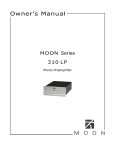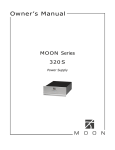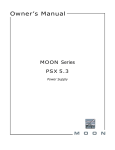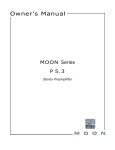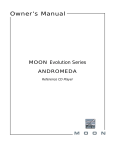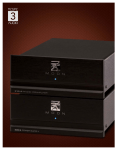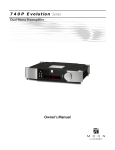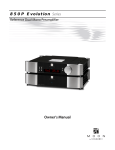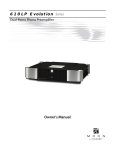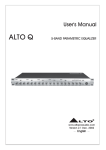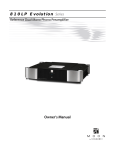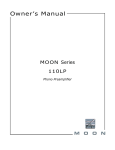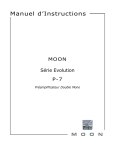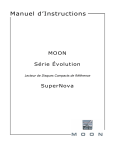Download Owner`s Manual
Transcript
Owner’s Manual MOON Series 310 LP Phono Preamplifier MOON 310LP Phono Preamplifier Important Safety Instructions 1. Read these instructions. 2. Keep these instructions. 3. Heed all warnings. 4. Follow all instructions. 5. Do not use this apparatus near water. 6. Clean only with a dry cloth. 7. Do not block ventilation openings. Install in accordance with the manufacturer’s instructions. 8. Do not install near any heat sources such as radiators, heat registers, stoves or another apparatus that produces heat. 9. Do not defeat the safety purpose of the polarized or grounding type plug. A polarized plug has two blades with one wider than the other. A grounding-type plug has two blades and a third grounding prong. The wide blade or the third prong is provided for safety. If the provided plug does not fit into the outlet, consult an electrician for replacement of the obsolete outlet. 10. Protect the power cord from being walked on or pinched, particularly at plugs, convenience receptacles, and the point where they exit from the apparatus. 11. Only use attachments and accessories specified by the manufacturer. 12. Use only with the cart, stand, tripod, bracket, or table specified by the manufacturer or sold with the apparatus. When a cart is used, use caution when moving the cart/apparatus combination to avoid injury from tip over. 13. Unplug this apparatus during lightning storms or when unused for long periods of time. 14. Refer all servicing to qualified service personnel. Servicing is required when the apparatus has been damaged in any way, such as when the power cord or plug has been damaged; liquid has been spilled or objects have fallen into the apparatus; or the apparatus has been exposed to rain or moisture, does not operate normally, or has been dropped. 15. No naked flame sources, such as candles, should be placed on the apparatus. WARNING: TO REDUCE THE RISK OF FIRE OR ELECTRIC SHOCK, DO NOT EXPOSE THIS APPLIANCE TO RAIN OR MOISTURE. ____________________________________________________________________________________ MOON 310LP Phono Preamplifier Important Safety Instructions (cont’d) The lightning flash with the arrowhead symbol, within an equilateral triangle, is intended to alert the user to the presence of uninsulated “dangerous voltage” within the product’s enclosure that may be of sufficient magnitude to constitute a risk of electric shock to persons. The exclamation point within an equilateral triangle is intended to alert the user to the presence of important operating and maintenance (servicing) instructions in the literature accompanying the appliance. Marking by the “CE” symbol (shown left) indicates compliance of this device with the EMC (Electromagnetic Compatibility) and LVD (Low Voltage Directive) standards of the European Community Please read all instructions and precautions carefully and completely before operating your Simaudio MOON 310LP Phono Preamplifier. 1. ALWAYS disconnect your entire system from the AC mains before connecting or disconnecting any cables, or when cleaning any component. 2. The MOON 310LP must be terminated with a three-conductor AC mains power cord which includes an earth ground connection. To prevent shock hazard, all three connections must ALWAYS be used. Connect the MOON 310LP only to an AC source of the proper voltage; Both the shipping box and rear panel serial number label will indicate the correct voltage. Use of any other voltage will likely damage the unit and void the warranty. 3. AC extension cords are NOT recommended for use with this product. 4. NEVER use flammable or combustible chemicals for cleaning audio components. 5. NEVER operate the MOON 310LP with any covers removed. There are no user-serviceable parts inside. An open unit, especially if it is still connected to an AC source, presents a potentially lethal shock hazard. Refer all questions to authorized service personnel only. 6. NEVER wet the inside of the MOON 310LP with any liquid. If a liquid substance does enter your MOON 310LP, immediately disconnect it from the AC mains and take it to your MOON dealer for a complete checkup. 7. NEVER spill or pour liquids directly onto the MOON 310LP. 8. NEVER block air flow through ventilation slots or heatsinks. 9. NEVER bypass any fuse. 10. NEVER replace any fuse with a value or type other than those specified. 11. NEVER attempt to repair the MOON 310LP. If a problem occurs contact your MOON dealer. 12. NEVER expose the MOON 310LP to extremely high or low temperatures. 13. NEVER operate the MOON 310LP in an explosive atmosphere. 14. ALWAYS keep electrical equipment out of reach of children. 15. ALWAYS unplug sensitive electronic equipment during lightning storms. ____________________________________________________________________________________ MOON 310LP Phono Preamplifier Table of Contents Congratulations ............................................... 5 Unpacking and Warnings ................................... 5 Introduction .................................................... 6 Installation & Placement ................................... 6 Circuit Board Layout ......................................... 7 Internal Settings .............................................. 8 Using the 310LP with an External Power Supply ...11 Rear Panel Connections ....................................12 Operating the 310LP ........................................13 Specifications .................................................14 www.simaudio.com Revision no.: 20091110 ____________________________________________________________________________________ MOON 310LP Phono Preamplifier Congratulations! Thank you for selecting the MOON 310LP Phono Preamplifier as a part of your music/cinema system. This component has been designed to offer state-of-the-art high-end performance in an elegant package, while retaining all the sonic hallmarks on which Simaudio has made its reputation. We have spared no effort to ensure that it is amongst the finest phono preamplifiers available. We have been building high-performance audio equipment for over 25 years, and the know-how gained through our cumulative experience is an important reason why MOON audio components are so musically satisfying. The performance of your 310LP will continue to improve during the first 300 hours of listening. This is the result of a “breakin” period required for the numerous high quality electronic parts used throughout this phono preamplifier. Before setting up your new MOON 310LP, we encourage you to please read this manual thoroughly to properly acquaint yourself with its features. We hope you enjoy listening to the MOON 310LP Phono Preamplifier as much as the pride we have taken in creating this fine audio product. We understand the power and emotion of music and build our products with the goal of faithfully capturing these elusive qualities. The information contained in this manual is subject to change without notice. The most current version of this manual is available on our official website at http://www.simaudio.com/manuals.htm Unpacking The MOON 310LP Phono Preamplifier should be removed from its box with care. The following accessories should be included inside the box with your phono preamplifier: 9 9 9 9 AC power cable 5/64” Allen key to remove the chassis cover and make internal adjustments This owner’s manual Warranty and product registration information (USA and Canada only) As soon as the phono preamplifier is safely removed from its box and placed down, perform a thorough physical inspection and report any physical damage to your dealer immediately. We suggest that you keep all of the original packaging, storing it in a safe, dry place in the event that you’re required to transport this product. The customized packaging is specially designed to protect the MOON 310LP Phono Preamplifier from potential damage that may occur during shipping. Please write the serial number of your new Simaudio MOON 310LP in the space provided below for future reference. Serial No.: ________________ ____________________________________________________________________________________ Congratulations / Unpacking 5 MOON 310LP Phono Preamplifier Introduction Your MOON 310LP Phono Preamplifier incorporates many significant design features to achieve its “world class” level of performance. This is an abbreviated list of the more important features: Isolated power supply on a separate circuit board using a toroidal transformer with 2 stages of voltage regulation. An extremely short signal path for a faster transient response. End-user adjustments for capacitance loading, resistance loading and gain level to extract exceptional performance from virtually all high quality phono cartridges. End-user adjustments to alternate between the RIAA and IEC equalization curves. Single-ended RCA and Balanced XLR output connectors. Optional external power supply. Power supply voltage regulation includes i2DCf (Independent Inductive DC Filtering) derived from the Evolution Series for increased dynamic range. Four-layer PCB tracings with dedicated ground and power planes using pure copper for low impedance characteristics. The advantages are better circuit layouts resulting in much shorter signal paths and a vastly improved signal-to-noise ratio. Rigid chassis construction to minimize the effects of external vibrations. A symmetrical circuit design with accurate matching of the very finest high quality electronic components. Designed to be powered up at all times for optimal performance. Low operating temperature for a longer than normal life expectancy. Installation & Placement The MOON 310LP requires reasonable ventilation to maintain an optimum and consistent operating temperature. As a result, it should be placed in a location with empty space around it for proper heat dissipation. As well, it should be placed on a solid level surface. You should avoid placing it near a heat source or inside a closed cabinet that is not well ventilated as this could compromise this component’s performance and reliability. You should never place another component directly on top of this phono preamplifier. The 310LP is more sensitive than most other types of audio components to EMI (electro-magnetic interference) from power supplies and motors. Consequently, it should be placed at a minimum distance of 18 inches from power supplies, turntables, tape decks, AC line filters, etc. IMPORTANT: A turntable with a functional cartridge MUST be connected to the MOON 310LP Phono Preamplifier prior to connecting the AC power cord, otherwise you may damage your amplifier and/or loudspeakers. ____________________________________________________________________________________ Introduction / Installation & Placement 6 MOON 310LP Phono Preamplifier Circuit Board Layout A B A B C C D D Figure 1: MOON 310LP Circuit Board layout Available Settings: A – Resistance loading jumper bank B – Capacitance loading jumper bank C – Equalization curve jumper bank D – Gain level jumper bank ____________________________________________________________________________________ Circuit Board Layout 7 MOON 310LP Phono Preamplifier Internal Settings There are four (4) types of input settings available on the MOON 310LP Phono Preamplifier; Capacitance loading, Resistance loading, Equalization curve and Gain level. Each setting is adjustable through the use of jumpers. For each type of setting, there are 2 banks of jumpers – one each for the left and right channels. This is the result of the 310LP’s genuine mirrorimage circuit design which yields exceptional stereo separation. Always place the preamplifier that your 310LP is connected to, either into mute or stand-by mode prior to changing any of the following input settings. Then disconnect the AC power cord from the rear of the 310LP. There are a total of eight (8) screws that you must remove using the included allen-key four each on either side of the chassis. Once these screws are removed, carefully lift off the chassis cover. Once the cover is removed, you are ready to make all of the necessary internal adjustments to the 310LP to achieve optimal sonic performance. Resistance Loading: There are five (5) different settings available for setting the resistive load; 10Ω, 100Ω, 470Ω, 1kΩ and 47kΩ which are represented by jumper sockets J9, J10, J11, J12 and J13 respectively for the left channel and jumper sockets J27, J28, J29, J30 and J31 for the right channel (refer figure 2 below). The factory default setting is 47kΩ, therefore jumpers will be found in sockets J13 & J31. Figure 2: Left and right channel jumper banks for resistance load adjustments at default setting In the event that you’re using a moving magnet (MM) cartridge, it is recommended that you leave the jumpers inserted in sockets J13 & J31 (the factory default) for a 47kΩ resistive load. Conversely, if you’re using a moving coil (MC) cartridge, experiment with the four (4) other available loads ranging from 10Ω through 1KΩ, selecting the load that provides the best possible sound quality. For example, if you decided on using the resistance setting of 100Ω, then you would insert the supplied jumpers into sockets J10 and J28 (see figure 3 below). Figure 3: Left and right channels set to a 100Ω resistance load One of the five jumper sockets for each channel must always have a jumper inserted into it, otherwise the 310LP will not produce an output signal. As well, you should always maintain the same resistance setting for both channels, otherwise sound will vary between the left and right channels of your audio system. ____________________________________________________________________________________ Internal Settings 8 MOON 310LP Phono Preamplifier Internal Settings (cont’d) Capacitance Loading: There are three (3) different settings available for setting the capacitive load; 0pF, 100pF and 470pF which are represented by jumper sockets J6, J7 and J8 respectively for the left channel and jumper sockets J24, J25 and J26 for the right channel (refer figure 4 below). The factory default setting is 100pF, therefore jumpers will be found in sockets J7 & J25. Figure 4: Left and right channel jumper banks for capacitance load adjustments at default settings Typically, capacitance loading adjustments will only impact the sonic performance of a MM cartridge. We recommend that when using a MC cartridge, you should set the capacitance load to 0pF by placing the supplied jumpers into sockets J6 and J24, respectively for the left and right channels. In the event that you’re using a MM cartridge experiment with the three (3) available loads, selecting the load that provides the best possible sound quality. For example, if you decided on using the capacitance setting of 470pF, then you would insert the supplied jumpers into sockets J8 and J26 (refer to figure 5 below). Figure 5: Left and right channels set to a 470pF capacitance load One of the three jumper sockets for each channel must always have a jumper inserted into it, otherwise the 310LP will not produce an output signal. As well, you should always maintain the same capacitance setting for both channels, otherwise sound quality may vary between the left and right channels of your audio system. Equalization Curve: The MOON 310LP Phono Preamplifier is equipped with circuitry for two (2) different equalization curves; The RIAA standard and the less common IEC modified curve. The main difference is that the RIAA curve produces a flat frequency response from 20Hz to 20kHz; The IEC curve acts as a subsonic filter removing inaudible infrasonic bass below 20Hz. Jumper sockets J5 and J21, for the left and right channels respectively, are used to set the 310LP’s equalization curve. These jumpers sockets have three pins allowing for 2 different possible positions. The factory default position is for the RIAA curve as shown below in figure 6 where the jumper connects the lower 2 pins. To select the IEC curve, place the jumper over the upper 2 pins as shown in figure 7 below. Figure 6: RIAA Equalization curve jumper setting Figure 7: IEC Equalization curve jumper setting To determine which curve you should use, do as follows: with the 310LP set to the RIAA curve, watch the movement of your loudspeaker’s bass drivers – if their motion doesn’t follow the pattern of the record currently playing and/or you see excessive driver movement, chances are you should use the IEC curve to eliminate the subsonic information not present on the record. ____________________________________________________________________________________ Internal Settings 9 MOON 310LP Phono Preamplifier Internal Settings (cont’d) Gain Setting: There are four (4) gain settings available on the MOON 310LP. They are 40dB for MM cartridges and 54dB, 60dB and 66dB for MC cartridges. However, keep in mind that when using the balanced XLR outputs, each of these gain levels increase by a factor of 6dB to 46dB, 60dB, 66dB and 72dB respectively (note: to keep the circuit board labelling simple, only the singleended RCA gain levels are indicated). There are three (3) jumpers sockets for each channel that are used to adjust the gain level setting; J16, J17 and J18 for the left channel; J32, J33 and J34 for the right channel. Each of these jumpers sockets have three pins allowing for 2 different possible positions. As well, there is a detailed diagram printed on the circuit board, located just below and to the right of each of these jumper banks, that shows the jumper positioning for the four available gain settings (see figure 8 below). Figure 8: Left and right channel jumper banks for gain level settings The factory default gain setting is 40dB, whereby all three jumpers in each bank are mounted to the left. In the event that you are using a MC cartridge, you will need to change the gain setting to either 54dB, 60dB or 66dB. The basic rule to determine gain for a MC cartridge is as follows: For a low output MC cartridge (0.7mV and lower), set the gain level to 66dB; for a medium output MC (0.7mV to 1.5mV) set the gain level to 60dB; for a high output MC (> 1.5mV) set the gain level to 54dB. However, as is the case with the other internal settings, let your ears be best judge as to what the best sounding gain setting should be. When using a MM cartridge, never set the gain above 40dB, otherwise you will overload the 310LP’s circuit, resulting in a very distorted output signal. To select a gain level of 60dB, you would mount the jumpers for sockets J16, J17, J32 and J33 to the right, and the jumpers for sockets J18 and J34 to the left as shown in figure 9 below. Figure 9: Left and right channels set to a gain level of 60dB Once you’ve completed all necessary adjustments, carefully place the chassis cover back into place, making sure that the eight screw holes line up with their respective sockets on the main chassis, and replace the screws using the included allen-key. ____________________________________________________________________________________ Internal Settings 10 MOON 310LP Phono Preamplifier Using the 310LP with an External Power Supply The MOON 310LP Phono Preamplifier can be operated with the optional MOON 320S Power Supply (purchased separately). Referring to figure 10 below, you will see an array of four (4) jumper sockets labeled STR1, STR2, STR3 and STR4. The factory default position for the 2 jumpers is in sockets STR2 and STR4 (positions B in figure 10). To properly use the MOON 310LP in conjunction with the MOON 320S, you will need to move these 2 jumpers into sockets STR1 and STR3 (positions A in figure 10). For further details, please refer to your MOON 320S owner’s manual. In the event that you are using the MOON P-8 Controller as power supply, these 2 jumpers must remain in sockets STR2 and STR4 (positions B in figure 10). Failure to make these adjustments may cause damage that is not covered by warranty. A B A B Figure 10: MOON 310LP Circuit Board layout ____________________________________________________________________________________ Using the 310LP with an External Power Supply 11 MOON 310LP Phono Preamplifier Rear Panel Connections Figure 11: MOON 310LP Rear panel The rear panel will look similar to Figure 11 (above). There is one pair of single-ended inputs on RCA connectors located in the center with a ground post directly below. Connect the cables from your turntable to these inputs and the ground lead wire to the ground post. The MOON 310LP Phono Preamplifier has two pairs of outputs; One single-ended pair on RCA connectors and one balanced pair on XLR connectors. In the event that the preamplifier/integrated amplifier you’re connecting the 310LP to has balanced inputs, its highly advantageous to use the 310LP’s XLR outputs. This will provide you with an even better signal-to-noise ratio and increased gain by a factor of 6dB. Don’t hesitate to use high quality interconnects. Poor quality cables can degrade the overall sonic performance of your system. Finally on the right side the IEC receptacle, labeled “AC Power” for the included AC power cord. Directly above the IEC receptacle is a 4-pin XLR connector labeled “DC Power”; this is for the optional 310LP external power supply upgrade. All rear panel connectors have been chosen because they provide the best possible connections for your unit. A poor contact will degrade the signal substantially, and plugs and sockets should all look clean and free of dirt and corrosion. The easiest way to clean them is to remove the cables from their sockets and push them back in again. This procedure requires that your Phono Preamplifier and the rest of your components be completely turned off. Not heeding this warning may result in serious damage to your equipment. Special contact cleaning fluids and enhancers should not be used, as they deposit a difficult to remove residue which can degrade the performance of your components over the long term. ____________________________________________________________________________________ Rear Panel Connections 12 MOON 310LP Phono Preamplifier Operating the 310LP We recommend that you leave your MOON 310LP Phono Preamplifier powered up at all times to maintain optimal performance. In the event that you plan to be away from your home for a few days, powering off the Phono Preamplifier may not be a bad idea. Once fully “broken-in”, please keep in mind that your 310LP will require several hours of playing time before it reaches its peak performance after you’ve powered it up again. IMPORTANT: A turntable with a functional cartridge MUST be connected to the MOON 310LP prior to connecting the AC power cord, otherwise you may damage your amplifier and/or loudspeakers. Making the AC Connection Connect the supplied AC power cable to the IEC receptacle, located on the rear panel of the phono preamplifier’s chassis. Ensure that the AC wall outlet you use has a functioning ground. For the best sonic performance, it is preferable that you plug your MOON 310LP directly into a dedicated AC outlet and avoid using an extension cord. In order to obtain the maximum performance from your audio system, we strongly recommend that the detachable power cord not come into physical contact with any of the interconnect cables running to and from your 310LP. In the event that this can’t be avoided, you should ensure that any cables coming into contact with each other are crossed at ninety degree angle to minimize the contact area. Powering up your MOON 310LP for the first time Since this Phono Preamplifier is not equipped with an on/off power switch, when connecting/disconnecting the AC power cord you are actually turning the unit on/off. Prior to making the AC connection for the first time, make sure that every cable is properly connected to avoid any problems. Once the 310LP is connected to an AC source, The blue LED on the unit’s front panel will illuminate. On and Off Sequence To avoid having any annoying noises (ie. “thumps” and “pops”) emanate from your speakers when powering your 310LP on or off, you should 1) Always power up your 310LP before powering up your preamplifier and/or integrated amplifier. 2) Always power down your 310LP after powering down your preamplifier and/or integrated amplifier. ____________________________________________________________________________________ Operating the 310LP 13 MOON 310LP Phono Preamplifier Specifications Circuit Layout ......................................................... Power Supply Transformer ....................................... Power Supply Capacitance ...................................... Single-ended inputs ................................................. Input Impedance - Adjustable ................................. Input Capacitance - Adjustable ............................... Single-ended output ............................................... Balanced output ..................................................... Gain – Adjustable (for single-ended outputs) .......... Gain – Adjustable (for balanced outputs) ................. Input overload @ 40dB gain .................................... Input overload @ 54dB gain .................................... Input overload @ 60dB gain .................................... Input overload @ 66dB gain .................................... Signal-to-noise Ratio (full scale @ 40dB gain) ......... Signal-to-noise Ratio (full scale @ 40dB gain) ......... Signal-to-noise Ratio (full scale @ 66dB gain) ......... Signal-to-noise Ratio (full scale @ 66dB gain) ......... Maximum Output (1kHz @ 10KΩ) ............................ Frequency Response – RIAA & IEC Curve ................. IEC Curve Effect....................................................... Crosstalk @ 1kHz ................................................... Intermodulation Distortion ...................................... THD (20Hz - 20kHz) .............................................. Power Consumption ................................................ AC Power Requirements ......................................... Shipping Weight ..................................................... Dimensions (W x H x D, inches) .............................. Mirror-image symmetrical circuit 10VA 14,000µF 1 pair (RCA) 47, 100, 470, 1k, and 47kΩ 0, 100, and 470 pF 1 pair (RCA) 1 pair (XLR) 40, 54, 60 and 66dB 46, 60, 66 and 72dB 58mV RMS 11mV RMS 6mV RMS 3mV RMS 110dBr 114dBr with 320S Power Supply 88dBr 92dBr with 320S Power Supply 6.0 Volts 20Hz - 20kHz (± 0.5dB) -7dB @ 10Hz -100dB < 0.009% < 0.001% 6 Watts 120V or 240V, 60Hz or 50Hz 7 lbs / 3 Kgs 8 x 3.25 x 11 Balanced Input Pin Assignment: Pin 1................................ Ground Pin 2................................ Positive Pin 3 .............................. Negative Fuse Replacement: For the 120V version use a 0.1A slow blow (5 x 20mm size). For the 230V version use a 0.1A slow blow (5 x 20mm size). ____________________________________________________________________________________ Specifications 14














